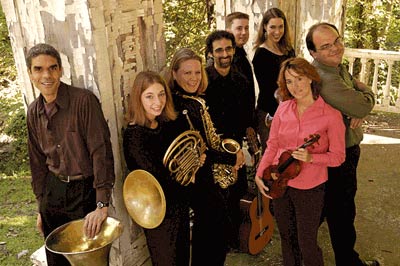Steve Reich's Great Noise
 On Tuesday, American composer Steve Reich turned 70. New Yorkers are enjoying a month-long festival of performances of Reich's music, Steve Reich @ 70, much of which will be commented on by Alex Ross and others. Here in Washington, there was only one opportunity, a concert last night by the recently formed Great Noise Ensemble at the Unitarian Universalist Church in Silver Spring.
On Tuesday, American composer Steve Reich turned 70. New Yorkers are enjoying a month-long festival of performances of Reich's music, Steve Reich @ 70, much of which will be commented on by Alex Ross and others. Here in Washington, there was only one opportunity, a concert last night by the recently formed Great Noise Ensemble at the Unitarian Universalist Church in Silver Spring.
The program began with a favorite of mine, Music for Pieces of Wood, for five claves players. The piece, from 1973, uses pure rhythm as a way to reduce Reich's phasic layering to its most basic level. It is a good example of how, even with the simplest musical materials, Reich composes music that is extraordinarily complex and difficult to realize. This was a good performance, with a minimum of glitches, a few uneven rhythms. The only truly noticeable concern was the stray beat that marred the piece's sudden ending. Concluding the first half was a landmark piece in Reich's phasic style, Electric Counterpoint (1987), for electric guitar and recorded tape. Not unlike Violin Phase and New York Counterpoint, the performer records himself in several tracks and then plays the final part live against himself on the recording. Guitarist D. J. Sparr could be seen counting silently, his lips moving, as he navigated the live part's entrances, but the performance was generally solid, especially in the third movement, where the jagged theme makes much sharper, shorter phases. Later this month, at an October 21 concert at Carnegie Hall as part of Steve Reich @ 70, Pat Metheny will play Electric Counterpoint, nearly 20 years after he premiered this piece composed for and in consultation with him.
Charles T. Downey, Steve Reich at 70 (October 3, 2006) Charles T. Downey, Music for Pieces of Wood (November 7, 2005) Jens F. Laurson, City Life / New York Counterpoint (August 6, 2005) |
I appreciate the piece, which I actually heard for the first time, and it has a lot of pretty effects, especially the crotales sounds in the last movement and the vibraphone and marimba sounds in the third movement (Psalm 18). For me, the piece falls flat, as it is kind of monochromatic in terms of tempo and color. The combination of texts could mean a lot of things (the other movements are based on Psalm 19 and Psalm 34), but Reich has not said much about it, except that the musical content is not at all based on Jewish themes. It is perhaps uncharitable to criticize the performers, who did such a service by bringing us Reich's music this week, but the music's construction makes rhythmic coordination very difficult. Instruments on sustained parts, especially the strings, did not always line up with the active parts, and tuning when the writing went into the stratosphere was sometimes sour. It was a valiant performance, whose imperfections did not mar the audience's general enjoyment of Steve Reich's birthday celebration.
The next concert by the Great Noise Ensemble will be on November 17 at 8 pm at the Sumner School (1201 17th Street NW), featuring music by the group's music director, Armando Bayolo, Heather Figi, Blair Goins, and the group's guitarist, D. J. Sparr.





















































1 comment:
Thanks for coming to the show!
Here's a blurb about my piece on the next concert:
General Electric is an eighteen-minute concerto grosso for electric guitar, electric bass, synthesizer, percussion and large chamber ensemble. The electric guitar, electric bass, synthesizer and percussion form the concertino section. The ripieno section consists of flute/piccolo, oboe, clarinet in Bb, tenor saxophone, baritone saxophone, bassoon, horn in F, trumpet, trombone, and strings. Due to the nature of guitars, synthesizer, and percussion, and including the influence of current and past popular culture and music into the composition of the work, General Electric is a union of contemporary classical music, baroque music, and rock-and-roll.
The work is divided into seven movements and begins with a theme that occurs in the beginning, middle, and end of the work. At times, the concertino is a quartet at the foreground of the musical environment while at other times it is an accompaniment to instruments from the ripieno section. In addition to this, each member of the concertino has individual soloist obligations. As the composition unfolds, the guitar and synthesizer modify their sounds for different sections of the piece. For example, the guitar uses a “clean sound” reminiscent of a rounded warm jazz guitar; this is buttressed in the outer movements by a distorted tone found in “heavy metal” music. In various movements, the synthesizer uses the sounds of very high pitched steel-drums, a harmonica, an “orchestra hit” (which is a sample of an orchestra performing one note), a harpsichord, and a sweeping electronic sound which emulates avant-garde music. Using a digital delay effect – which is the exact repeat of the articulated notes at a set duration – canonic motives result in the guitar and synthesizer. This culminates in a movement entitled “Echoplex,” where a melody is orchestrated in the ensemble in a way that makes it sound as if it is echoing, though no electronic effects are used.
(nice plug, huh?)
Post a Comment